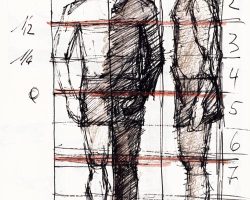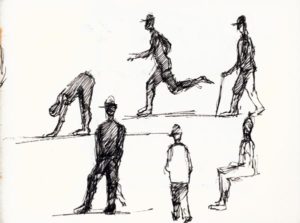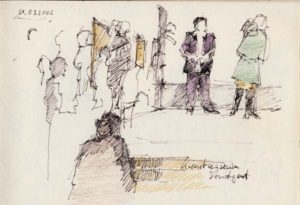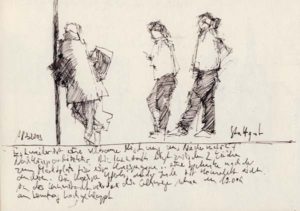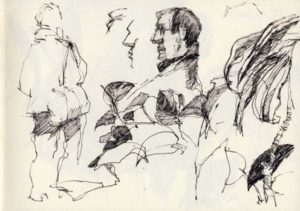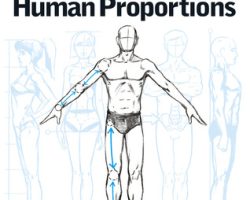
Foreshortening in the art of drawing
What is foreshortening? Some answers and drawing examples and video tutorial
What is foreshortening? Foreshortening in the arts refers to a specific way to depict three dimensional objects on the two dimensional paper planes. One of the most famous examples of foreshortening in visual arts is the painting by Andrea Mantegna, the mourning of Christ. The painting on wood shows the dead body of Christ from an extreme perspective. The viewer is put on the same eye level as the mourning figures at the side in close distance at the very end of the bed near the feet.
The painting was done in the 15th century in Italy, a period called Renaissance. During that time depiction of three dimensional spaces was fully explored and displayed in visual arts with almost scientific “correctness”.
Foreshortening in this painting means the perspective compression of the body and it’s proportions to a fraction of the actual size. Feet and head come very close together; the limbs are foreshortened in perspective. Mantegna created a stunning and very dynamic piece by choosing this extreme perspective.
Foreshortenings are inseparable connected with the depiction of illusionist three dimensional spaces. Until the 13th century pictures were mostly flat, at least space often was not depicted “correctly” and thus lacked the illusionist effect. Since Mantegna and others renaissance artists drawing and painting foreshortenings has become the standard of illusionist painting.
Andrea Mantegna – the mourning of Christ
An impressive example for foreshortening in visual arts

Image credit: Wiki media commons An impressive example for foreshortening in visual arts
Using a grid to draw foreshortening

The image above is from the 18th century. In the old days using grids in drawing was the state of the art method to produce exact perspective drawings. The draughtsman has a paper with the same grid proportions on his drawing table. All he has to do is to transfer important points where outlines in the scenery cut the vertical grid on the grid on his paper. Then he can connect those points to reproduce the outlines of trees and other objects in the drawing to get an exact flat projection of his view on the drawing paper.
There is a very famous illustration by Albrecht Dürer in his tutorial on how to measure in drawing. It illustrates perfectly how foreshortening in perspective drawings of the human body can be obtained. There is also the vertical grid used to transfer a flat projection of a there dimensional space on the flat surface of the drawing paper.
The effects of foreshortening in drawing
Extreme perspective with foreshortening effect changes a couple fo things. What are the effects of foreshortening in drawing?
1. Foreshortening changes geometric forms: circles will change to elliptic forms, squares will change to rectangles and cylindrical subjects change to a more conical shape for example
2. Foreshortening changes proportions: foreshortening on the human body will change the proportions for example. Parts which are closer to the viewer’s eye can appear much bigger than from a “standard” figure drawing. Limbs might look much shorter, hands or feet might look bigger.
Super retro comic hero thinks about a fly

Video lesson in drawing foreshortening
In this video lesson you can see an example of a manga or cartoon figure stretching the hand directly to the viewer in extreme perspective. As the hand is much closer to the viewer than the body the hand is bigger in size than the head of the figure. This is one of the dynamic effects of an extreme perspective look. The artist shows in real time how he develops the position of hand, palm and fingers in relation to the perspective extremely shortened arm. The video demonstrates the characteristics of foreshortening very well.
Drawing Tutorial: Foreshortening
by markcrilley
Extreme foreshortening as means of a drawing composition
Foreshortening in drawing, charcoal drawing, houses and street
This charcoal drawing of mine (Basic tips for charcoal drawing) uses an extreme perspective with foreshortening as dynamic composition concept. The viewer is massively forced to follow the fence line from the foreground in to a mad dash down the road to the center of the image.
Foreshortening applied in a street sketch
foreshortening in a street sketch
This is a detail of one of my humble sketches of the city of Stuttgart. In the center there are some cars parked and the effect of foreshortening is compressing the outlines of the chassis. It is rather difficult to draw the wheels not as circles but as flat ellipses and the wheel wells so very narrow to shorten the sideview of the vehicle according to the perspective. It helps a lot to close one eye to observe and see the object as it would look as flat projection on paper.
Exercises to learn foreshortening in drawing
One can think of many exercised to learn foreshortening. The first one I did was taken from Bert Dodsons classic book “Key to drawing”. He request the reader to draw is/her own hand with the fingers pointing towards the viewer. It sounds easy but it is a quite tricky thing to do.
Drawing still life subjects like bottles , that are lying flat on a table for example, are also good exercises. Foreshortenings on the human body are a great challenge to
Drawing books that can help to understand foreshortening
In architecture drawing the term foreshortening is rarely used. Foreshortening mostly is mentioned in connection with drawing the human body. Here are two books that deal among others with this topic. especially in comic drawing foreshortening is an often used means to create dynamic and stunning sceneries.
The batman comics are well knwon for their extreme vertiginious perspective views of skyscrapers and the comic hero moving within this environment
Foreshortening in a tree sketch

This sketch is an exercise in drawing foreshortening. The base of old treet trunk pointed towards me. As a result the branches are very close together and the shape of the trunk appears to become a lot thinner from base to top.

